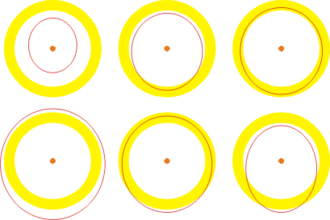
Special cases include inner-grazers (top row, in the middle) and outer-grazers (bottom row, in the middle), which do not completely cross the orbital band described by Mars. The other three diagrams describe a co-orbital configuration (top row, on the right) where the asteroid's orbit is contained within the orbital band of Mars, as well as a near-Earth asteroid such as an Amor asteroid (top row, on the left) and a main-belt asteroid, for example of the Hungaria family, which orbits are contained completely either inside or outside the orbit of Mars, respectively.
A Mars-crossing asteroid (MCA, also Mars-crosser, MC) is an asteroid whose orbit crosses that of Mars. Some Mars-crossers numbered below 100000 are listed here. They include the two numbered Mars trojans 5261 Eureka and (101429) 1998 VF31 .
Contents
- Co-orbital
- Inner grazers
- Inner grazers that are also Earth-crossers or grazers
- Mars-crossers that are also Earth-crossers or grazers
- Outer grazers
- Mars-crossers
- See also
- References
- External links
Many databases, for instance the JPL Small-Body Database (JPL SBDB), only list asteroids with a perihelion greater than 1.3 AU as Mars-crossers. An asteroid with a perihelion less than this is classed as a near-Earth object even though it is crossing the orbit of Mars as well as crossing (or coming near to) that of Earth. Nevertheless, these objects are listed on this page. A grazer is an object with a perihelion below the aphelion of Mars (1.67 AU) but above the Martian perihelion (1.38 AU). [1] The JPL SBDB lists 13,500 Mars-crossing asteroids. Only 18 MCAs are brighter than absolute magnitude (H) 12.5, [2] which typically makes these asteroids with H<12.5 more than 13 km in diameter depending on the albedo. The smallest known MCAs have an absolute magnitude (H) of around 24 and are typically less than 100 meters in diameter. There are over 21,600 known Mars-crossers [3] of which only 5751 have received a MPC number.
Earth having more gravity and surface area than Mars attracts more impactors than Mars. Earth is impacted about 20 times more than the Moon, [4] and Mars only gets impacted about 3 to 5 times more than the Moon. [5]